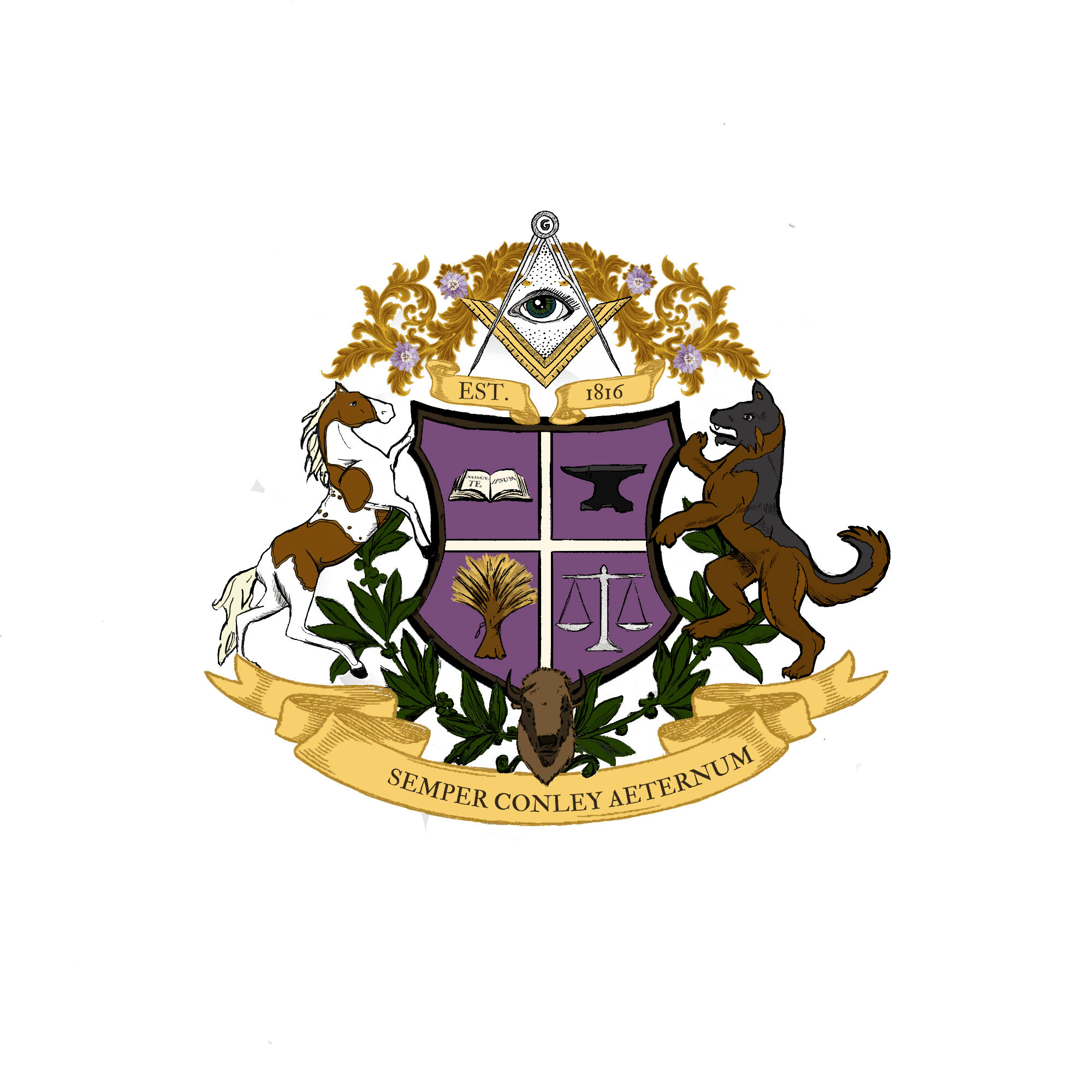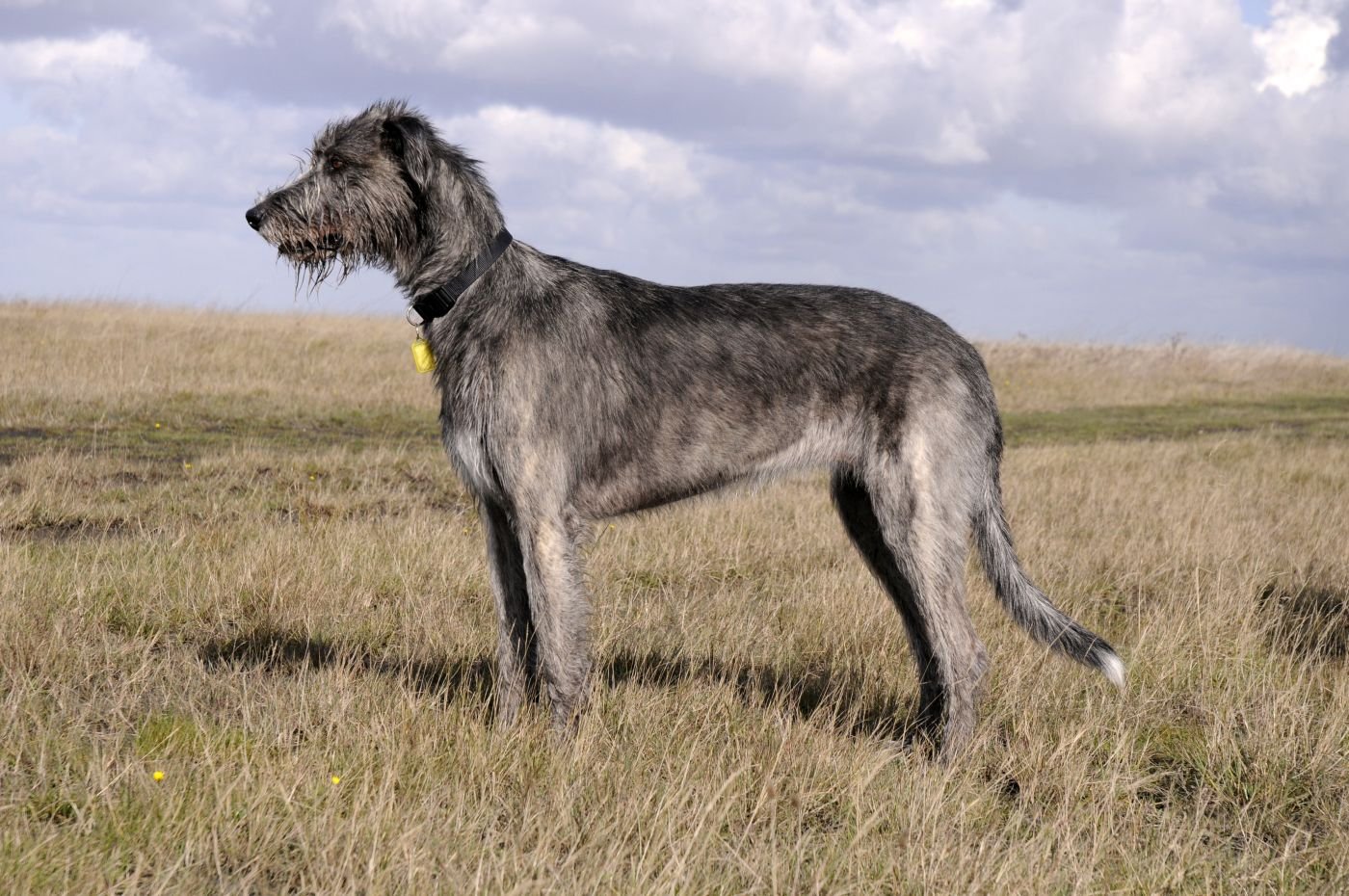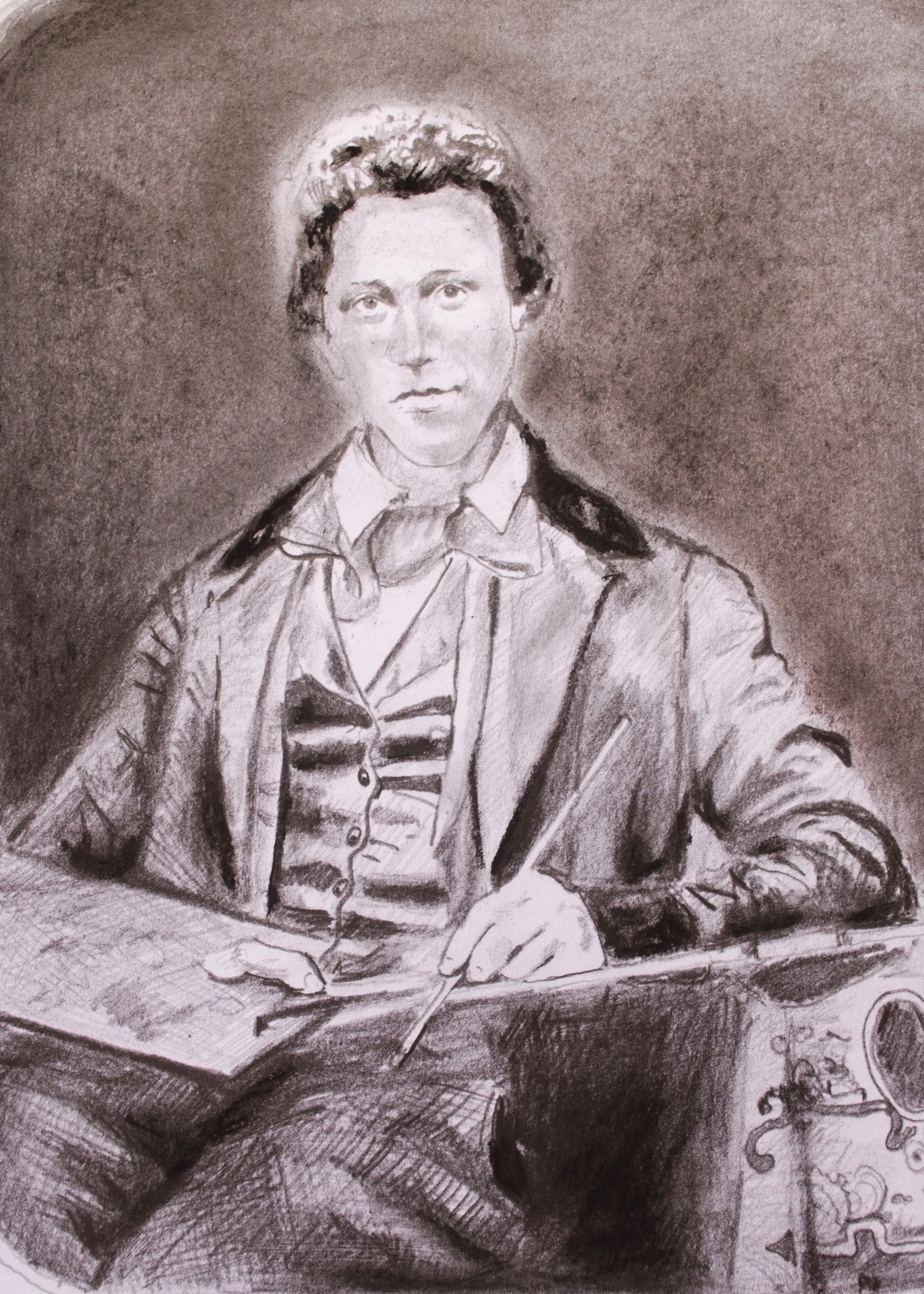WHAT’S IN A NAME ?
Since its earliest years, the Irish lineage has dominated the story of the Conley Family. Firstly, the Irish bloodline grew dominant through primogeniture. Secondly, red hair and green eyes were prevalent in family members, regardless of ethnicity. Thirdly, the CONLEY name was that most used by the family members to unite their identity.
The Gaelic-Irish surname Conghal (meaning, quite literally, "fierce as a wolfhound") evolved into “Ó Conghalaigh”, which itself was then anglicised and misspelled upon arrival in America. Connolly, Connally, Connelly, Konnelly, and finally, Conley, were the most common misspellings.
Many American families evolved the spelling of their ancestral names before settling on the famous spellings we now know. In other cases, a family founder literally selected a name randomly, a created an identity from thin air. In the case of the Conley name, it was a matter of simplification when the original organized family chose CONLEY.
The crest of County Donegal, Ireland. Origin of the Conley colors: Green and Yellow.
The Irish Wolfhound from which the name was inspired.
COUNTY DONEGAL
THE IRISH NAME AND SPIRIT DOMINATED
For those arriving from Ireland, there is more information, but not much more, than the Conley ancestors from Africa, Britain, Germany or other places. The first Conley to set foot in America appears to have been a James Connally, who arrived in Virginia from Donegal, Ireland in 1673. Government records show him altering his original name upon arrival from “O'Connolly” to Connally, while his brother adopted the spelling “Konnelly” in America. The first prominent member of the bloodline, John Oldham Cannally founded the Green Bottom Inn & Equestrian Resort in 1815, catapulting the name to national relevance for the first time, because of John’s friendships with U.S. Presidents Jackson, Polk and Monroe.
As was common in the 1800s, John Oldham Connally built Green Bottom Inn & Equestrian Center with a mix of African slave labor and European indentured servants. As was also a common occurrence, John had a child with one of his slaves. That child, James, was born circa 1800. It is highly unlikely that the conception was consensual. James was raised and trained as a carriage driver and footman by John and his brother. He was Caucasian in appearance, which made it easier to apprentice him for personal services of many kinds.
‘CONLEY’ BECAME THE STANDARD
By the time of John Oldham Connally’s death in 1845, James’ children had begun to be apprenticed for roles required for the upkeep of the equestrian resort. This would bring them great wealth.
Carpentry: Construction, Woodworking, Furniture, Metal works, Gardening, Cooking, Tailoring were among those vocations. All would be turned into lucrative businesses by John Oldham Connally’s illegitimate grandchildren after his death.
As James aged, he passed the authority for managing all of these businesses to Green Conley, his capable son-in-law married to eldest daughter Harriett. James demanded his sons spell their names consistently in the manner that Green Conley did. Thus everyone on the family began concisely spelling the name ‘Conley’ around 1850.
Although patriarchal, that is what made the family different - their level of coordination and formal organization was almost unheard of in the era. Those seven sons of James, led by son-in-law Green and James’ daughter Harriet, became ‘The Conley Boys’ with whispered reference to their shrewd, but fair, business dealings. Between 1845 and 1860 when the Civil War began, the Conley brothers from Huntsville made a lot of money. When building season began each spring they would travel West, Northwest, and North from Huntsville by train as prosperous white businessmen. Some of the Conleys disguised their curly hair with formal hats. When autumn turned to winter, they would return to Huntsville with vastly increased wealth, living openly as Free Colored gentry. Their travels spread the Conley name and their genes, across the fast-growing America of the Antebellum Period.
The Conley Brothers traveled by the rail to the West and Northwest of the Tennessee Valley, building barns, stables and homes as the country expanded the Western Frontier.
Conleys recycled their names aggressively to extend and reinforce their tenuous privilege. John, James, Green, Felix, Paschal, and Alexander were often used in the early 1800s. Benjamin, Isaac, Issac, and Charles were common in the late 1800s. The female names Harriet, Paralee, Sarah, and Jessie were also passed down aggressively. Nearly a dozen women were named ‘Harriet’ following the birth of the original Harriet in 1818, who became the queen bee of the family until her death in 1893. Charles was recycled again after 1900, driven by the prestige of Charles Hamilton Conley’s valor in World War 1. No less than six ‘Charles Conley’ men populated the family in the first half of the century. These names were like ‘assets’ conveying trust, competence, and respect. One ‘Paschal Conley’ followed another for a century.
Many of these names are still found throughout the extended family in modern day 2022. and that tradition continues to this day as another ‘Felix’ was born in 2018, and several ‘Alexander’ have been born since 2010.
An example of their use of names to extend privileges across the generations is shown below:
FELIX - A name in its 9th generation
FELIX CONLEY 1st (1819-1885) : Felix Conley the first was the son of James Conley, and grandson of John Oldham Connally. He was trained as an artisan painter, and painted much of the signage for the Green Bottom Equestrian Resort from the guest rooms, to the stables, and the directional signs throughout the resort. He would
The land title for Felix Conley 1st, confirming the land he acquired with the help of his father and brothers circa 1859, shortly before the Civil War.
Felix Conley II, grand nephew and namesake of Felix the 1st. Felix Conley II was the grandson of Harriet Conley, sister of Felix Conley the 1st. He died young at 35 at the home of his father Milton.
A new ‘FELIX’ is born. Lorraine Vannah Gregg, 3x-great-granddaughter of James Conley, holding her great-grandson Felix of the 9th generation of the family in 2018.
CHARLES - A century of PRESTIGE
The name ‘Charles’ rings eternal with four Conley figures who share this name, and made us proud to be Conleys of America.
At least 11 Conleys carried the name Charles, in the past century since Charles Hamilton Conley, of Montana who was the grand-nephew and namesake of Hamilton Conley, one of the original Conley Brothers and a gardener at Green Bottom Equestrian Inn.
PASCHAL & SCRUGGS - ENTERNAL NAMES
In the Conley Family, the familiar name ‘Paschal’ and the cognomen ‘Scruggs’ ring through the decades.
THE FIRST PASCHAL - PASCHAL CONLEY I (1822-1883) : Paschal Conley Sr. took over his father’s livery stable clients in Normal, Alabama. Paschal also took his father’s place as prominent figure at St. Bartley’s Baptist Church. He would become a prosperous figure in Huntsville and the first benefactor of the Lincoln School, predecessor to Alabama A&M. His son, Lieutenant Paschal Conley Jr. went on to become a celebrated soldier under General John J. Pershing.
EDGAR PASCHAL SCRUGGS (1907-1977) : Edgar Paschal Scruggs (on the right) with his brother James Scruggs. Edgar Paschal would be the 5th ‘Pachal’ in the family, all namesakes of Paschal the 1st.
THE SECOND PASCHAL, NEPHEW OF THE FIRST PASCHAL: Paschal Sr’s younger brother, William ‘Bill’ Conley, also named his first born Pachal II, who became known as ‘Pony’ to distinguish him from first cousin Paschal Jr., son of Paschal Sr.
After the deaths of his uncle Paschal and father William, ‘Pony’ ran the livery stable, cotton mill, meat processing, blacksmithing, and ironworks inherited from his uncle Paschal Sr. and father William ‘Bill’ Conley, while Paschal Jr. sought adventure with the Buffalo Soldiers. James Jr., brother of Paschal Sr. and ‘Bill’ Conley, and namesake of their common father, moved west to the border of Mississippi to buy land.
JAMES JR., SON OF PROGENITOR JAMES CONLEY, STABLEMASTER OF THE GREEN BOTTOM EQUESTRIAN SPORTING CENTER: James Conley Jr. Became a prosperous land owner and carriage maker. He tried to exploit the opening of new settlements to the west, along the Mississippi border, with disastrous consequences. Family lore is that he had a shotgun held to his jaw, and was forced to sign over his land. There would be many more James Conleys.
PASCHAL CONLEY the 3rd (1898-1985) : Paschal III, also called ‘Junior’ in his youth, was the son of Paschal ‘Pony’ Conley. He would inherit much of his grandfather William ‘Bill’ Conley’s land where the Colonial Golf Course in Madison County, stands today.
LEVI SCRUGGS (1842-1919), BARBER TO THE RICH IN HUNTSVILLE: Paschal Sr. shown above, helped Levi Scruggs, a former slave trained as a barber, to open his own shop in the center of Huntsville next to the livery stable. The business thrived, serving only wealthy white patrons, and making Paschal and Levi substantial earnings. “By the antebellum period, skilled black barbers . . . controlled the tonsorial market and offered their services to the white elite. Several owned their own shops. Many became successful entrepreneurs and leaders of their communities.” - Cambridge University Press, Law and History Review , Volume 37 , Issue 1 , February 2019 , pp. 89 - 124 . Photo Credit: “Scalp Dressing” engraving (Image courtesy of Jean-Francois Caron/The Graphic vol. XXIV, no. 612)
ZANN SCRUGGS (1876-1954) AND JESSIE CONLEY SCRUGGS, AN ARRANGED MARRIAGE: Stable operator Paschal Conley Sr. and prosperous barber Levi Scruggs had their descendants intermarry. Shown above, Zan Scruggs, the youngest son of Levi Scruggs and his wife Jessie Lee, granddaughter of Paschal Sr. after their move to Vermont.
LEVI BURGESS SCRUGGS, SON OF ZAN AND JESSIE SHOWN ABOVE: Burgess Scruggs was the pride and joy of of the Conley Family in Vermont. He reprised the role of Alexander Conley Ist, two generations early, as the handsome, athletic, and extroverted standard bearer. He is shown here with his wife, Yvonne who hailed from one of Vermont’s oldest families.
LEVI BURGESS SCRUGGS (1902-1972) : Levi Burgess Scruggs at University of Vermont in 1922. He carried both his father and cousin’s names to New England. Upon his move to Los Angeles, three of his brothers followed, taking the Scruggs name to the West Coast.




















